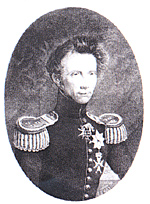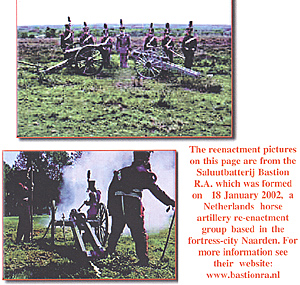Netherlands Artillery
in the Waterloo Campaign
Part II:
The Netherlands Artillery Officers
Prince (William) Frederick Carl van Oranje-Nassau
(Willem Frederik Karel, Prins der Nederlanden)
reviewed by Geert van Uythoven, The Netherlands
| |

Prince Frederick was born on 28 February 1797 in Berlin, son of the later King William I of the Netherlands and Her Royal Highness Frederika Wilhelmina Louisa, born Princess of Prussia. His youth was eventful. With his father fighting against the French, commanding a Division in the Prussian army, on 18 October 1806 his mother had to flee from Berlin with the children, his sister Pauline dying two months later, only six years old. On 23 March 1813 Prince Frederick was appointed by Wilhelm IV an officer in the Prussian 2nd Foot Guards Regiment. On 14 April he left for Altenburg, where the headquarters of Blucher were established. He was present in the battles of Lützen (Groß-Görschen, 2 May) and Bautzen (20 – 21 May). On 11 August, Prince Frederick transferred to Zieten’s Division on its way to Bohemia. On 22 August present with the fighting along the Saxon border. Also present at the battles of Dresden (26 and 27 August) and Kulm (30 August), and in September at the combats at Kulm and Telnitz (both on the 17th). From 16 to 19 October 1813 he was present at Leipzig, taking part in the recapture of Wachau and the combat at Probstheyda. On 18 October he received his patent as Stabs-Capitain of the infantry. With Kleist’s Corps, he took part in the pursuit of the French over Naumburg, Auerstädt and Weimar to Gotha. From 28 October – 22 November he was present at the blockade and bombardment of Erfurt. On 17 November 1813 he is again transferred, this time to the 3rd Prussian Army Corps (Bülow). He was on 29 November promoted to captain of the 2nd Prussian Foot Guards Regiment. On 6 December, Prince Frederick crossed the Netherlands border near Aalten, arriving in The Hague on the 8th. On 19 December he was before the fortress-city of ‘s Hertogenbosch. On 26 December appointed colonel of infantry in Netherlands service. He had a good start in 1814, when he was in Breda on 8 January, where the next day council of war was held together with Bülow and Lord Graham who commanded the British troops in the Netherlands. Although it was concluded that the forces at their disposal were to weak to undertake a serious attempt to capture Antwerp, it was still decided to continue the advance further. Prince Frederick joined the Prussians and was present at the small combats at Brecht and Westmalle (11 January). On 13 January the advance continued, with Prince Frederick joining the British that fought a combat at Austruweel, after which the British started an ineffective bombardment of the fleet and the harbour of Antwerp. On 1 and 2 February he was present at the combats near Deurne and Burgerhout. After that, with Bülow, Prince Frederick marched to Brussels and together they entered the ‘capital’ of the southern Netherlands. Crossing the French border on 18 February, he was present during the attack on and the capitulation of Soissons. Joining Marshal Blücher and present at the battle of Laon (9 – 10 March), Prince Frederick was slightly wounded in the face by splinters, when a cannonball hit a wagon near by. On 11 March promoted lieutenant-general in the Netherlands army, on the 19th he was ordered to return to the Netherlands, as there was a lot of work to do to build the army. To that purpose, Prince Frederick was appointed Grand Master of the Artillery 14 March 1814. After having been present at the opening of the bombardment of Naarden, a fortress-city near Amsterdam still occupied by the French, Prince Frederick returned to the south on 11 April 1814, appointed second in command of the Netherlands Army Corps, and commanding officer of the 1st Netherlands Division which was supporting the British in Flanders and before Antwerp. On 4 April 1815, Prince Frederick resumed commanded of the Netherlands Mobile Army. On 2 May he handed over command to the Hereditary Prince of Orange, instead receiving command of the Netherlands Indian Brigade and the Netherlands 1st Division, part of the 2nd Anglo-Allied Army Corps (Lord Hill). On 17 June after the battles of Ligny and Quatre-Bras had been fought Prince Frederick marched to Halle, taking up position there. Remaining there during the battle of Waterloo on the 18th, he advanced into France crossing the border on the 21st. Commanding the Netherlands Mobile Army during the absence of the Hereditary Prince of Orange who was wounded at Waterloo, he received orders from Wellington to blockade the nearby French fortresses and to maintain communications between the Netherlands and the Allied troops advancing on Paris, using the newly created 2nd Netherlands Army Corps.
On 8 July, he received the commanders-cross of the Militaire Willemsorde (‘Military Order of William’). On 16 July, the Heriditary Prince of Orange returned, resuming overall command of the Netherlands troops and the 1st Netherlands Army Corps in particular, leaving Prince Frederick in command of the 2nd Netherlands Army Corps. After the second abdication of Napoleon, Prince Frederick received command of Netherlands troops in France being part of the Allied occupation force, returning home in September 1815. On 21 July 1816 Prince Frederick, still holding a rank in the Prussian army as well (a colonel with the Infantry Regiment No.15 since 1 October 1815), was appointed Inhaber of the Infantry Regiment No.15. Continuing his Prussian career, he was promoted to lieutenant general of the Prussian army on 18 June 1825 and general of the infantry on 10 September 1840. Finally he was promoted General-Feldmarschall on 1 July 1874. But there was another Prussian bond. Prince Frederick married on 21 May 1825 with Her Royal Highness Louise Augusta Wilhelmina Amalia, Princess of Prussia (born 1 February 1808; died 6 December 1870). Together they would have four children. Back to his Netherlands military career now. Promoted general of the artillery on 15 June 1826, he became General-Commissary of War on 1 July 1826, Admiral of the fleet, and Colonel-General of the various arms of the Netherlands army on 25 December 1829. Honourably discharged from both latter positions on 6 July 1839. On 24 August 1830 a rising in Brussels started, which finally would lead to the independence of Belgium. Both princes left for the south, commanding the Netherlands army, to put down the rising. On 22 September Prince Frederick fought a combat with the rebels near Evere. Next day he was present at the affair at the Schaarbeeksche gate of Brussels, participating in the confused fighting that took place until the 26th of that month next day the royal troops abandoned Brussels, the rebels having the opportunity to form some kind of independent government for the southern provinces. On 22 March 1831 Prince Frederick was appointed commander in chief of the Mobile Army. On 29 July, he himself proposed to King William for the Hereditary Prince of Orange to take over command, which was passed over to him on 1 August, Prince Frederick remaining as an adjoint. Next day the so called ‘Ten Day Campaign’ (Tiendaagse Veldtocht) started, with the Netherlands army easily brushing away all resistance put up by the untrained Belgian army. On 12 August a truce was closed when a French army came to the aid of the Belgians, with the Netherlands Mobile Army returning to the province of Noord-Brabant on the 14th. Until 1834, Prince Frederick remained with the Mobile Army, with King William only ceding his Belgian provinces and making peace with Belgium on 19 April 1839. Prince Frederick was promoted Field Marshal of the Netherlands army on 28 November 1840. On 8 April 1849 as such he received supervision over all arms of the Netherlands army, as well as the Koninklijke Militaire Akademie (Royal Military Academy). In September 1856 he represented the Netherlands King at the crowning of Tsar Nicolas I in Moscow. Appointed Inhaber of the Russian Rostow Grenadier Regiment No.2. On 17 March 1863; the King of Prussia gave the name ‘Prinz Friedrich der Niederlanden’ to the 2nd Westphal-ian Infantry Regiment. On request of Prince Frederick himself, he was on 28 June 1868 honourably discharged from his task of supervising all arms of the Netherlands army. He died on 8 September 1881 in Wassenaar, and was buried in Delft on the 23rd of that month. Netherlands Artillery in the Waterloo Campaign 1815 Part II: Artillery Officers
Adriaan Bijleveld David Esaias Bode (Boode) Lodewijk Hendrik Du Bois A.Willem Du Pont Adrianus Rudolf Willem Gey Carel August Gunkel (Gunckel) Godfried Jacob Holsman Nicolaas Lodewijk Kaempfer Carel Frederik Krahmer de Bichin Martinus Antonius Kuytenbrouwer Frederik Carel List Johannes Hendrik Lux Prince (William) Frederick Carl van Oranje-Nassau (Willem Frederik Karel, Prins der Nederlanden) Abraham Petter Carel Jan Riesz Johan George Hendrik Scheffer Jacques-Louis-Dominique, Baron van der Smissen Johannes Nicolaas Spies Maximilian-Henry Steenberghe Emmanuel-Joseph Stevenart Hendrik Rudolph Trip Pieter Wijnands Leopold Winssinger Netherlands Artillery in the Waterloo Campaign 1815 Part I [FE71]
The Artillery in the Southern Netherlands The Artillery Arm in the Kingdom of the Netherlands Equipment and The Train Unit Info and Roster (very slow: 377K) Back to Table of Contents -- First Empire # 72 Back to First Empire List of Issues Back to MagWeb Master Magazine List © Copyright 2003 by First Empire. This article appears in MagWeb.com (Magazine Web) on the Internet World Wide Web. Other articles from military history and related magazines are available at http://www.magweb.com |
 The 1st Netherlands Army Corps participated in the advance on Paris. From 22 to 29 June, the 2nd Netherlands Army Corps besieged the fortress-city Quesnoy, which capitulated on the 29th. On that same day, Prince Frederick started blockading Valenciennes, changing the blockade in a proper siege on 1 July, bombarding the fortress-city which lasted to 10 July.
The 1st Netherlands Army Corps participated in the advance on Paris. From 22 to 29 June, the 2nd Netherlands Army Corps besieged the fortress-city Quesnoy, which capitulated on the 29th. On that same day, Prince Frederick started blockading Valenciennes, changing the blockade in a proper siege on 1 July, bombarding the fortress-city which lasted to 10 July.